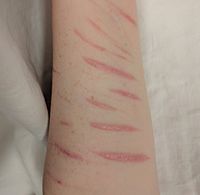
Photo from wikipedia
Functional analyses and treatments of self-injurious behavior and aggression have shown that such behavior is often operant. In this paper, we will revisit evidence that a subset of self-injurious and… Click to show full abstract
Functional analyses and treatments of self-injurious behavior and aggression have shown that such behavior is often operant. In this paper, we will revisit evidence that a subset of self-injurious and aggressive biting may be controlled primarily by antecedent events and may have phylogenetic origins. We propose that there is a research gap of more than four decades, if one considers the wealth of basic research on biting that occurred prior to 1977. To our knowledge, that body of basic research was never fully translated or directly applied within behavior analysis. It is known that organisms (including humans) sometimes bite in the presence of aversive events (broadly defined as the presentation of aversive stimuli or the removal of reinforcers). Thus, the variables controlling biting in the context of behavioral assessment and treatment require further analysis.
Journal Title: Journal of applied behavior analysis
Year Published: 2022
Link to full text (if available)
Share on Social Media: Sign Up to like & get
recommendations!